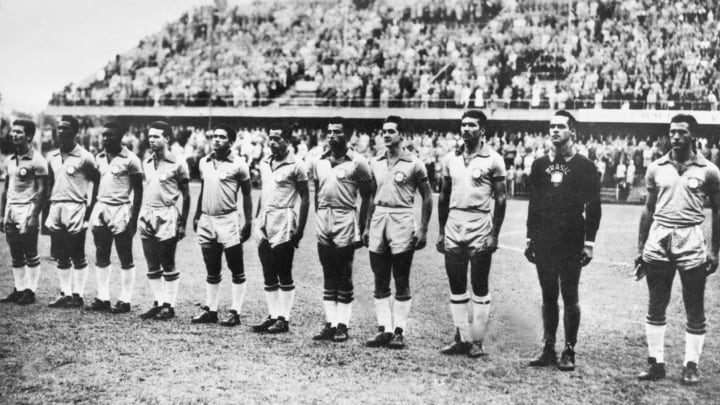Brazil 1958: The Real Birth of International Football's Most Iconic Kit

In the history of international football, there is no more iconic team and no more iconic kit than Brazil. The unmistakable yellow shirt with green trim, blue shorts and white socks has been worn by five sets of World Cup winners over the last 60 years, including many of the greatest players of all time, from Pele and Garrincha, to Ronaldo, Rivaldo and Ronaldinho.
But hard as it to think now, Brazil hasn’t always been synonymous with those yellow jerseys, with the colours known and adored the world over not much older than the first World Cup triumph in 1958. Until the 1950s, Brazil primarily wore…white.
Although present at the inaugural 1930 World Cup in Uruguay and the follow up in Italy in 1934, Brazil’s love affair with the tournament perhaps really began in 1938 in France.
The Seleção were the only South American nation to participate in the finals, but inspired by the goals of top scorer Leonidas reached the semi-finals and finished third. By the time the World Cup was next staged in 1950 it was in Brazil, who would likely have been handed the 1942 tournament had it not been cancelled as a result of the Second World War.
A nation expected. Brazil had utterly annihilated the competition at the 1949 Copa America, then still known as the South American Championship, and things looked to be going to plan at their home World Cup. Progression from the first group stage was followed by big wins over Sweden and Spain in the final stage round robin – this a World Cup format like no other.
In the last game against Uruguay, doubling as a de facto final given that their small neighbours were the only other team who could also lift the trophy, avoiding defeat would have been enough to crown Brazil champions of the world. But they couldn’t do it.
Despite taking the lead, Brazil crumbled at the Maracanã, the world-famous cathedral of football purpose built for the tournament. Scoring twice, Uruguay won the game and the trophy.
To suggest that the result sent a country into mourning would not be overstating it. From that moment on, the all-white strip was considered tainted by the tragedy of ‘Maracanazo’. It was only in 2019 when a special throwback kit was launched for the 100th anniversary of the first South American Championship in 1919 that Brazil eventually wore white again.
In the wake of 1950, Brazil’s white jersey wasn’t deemed to be suitably patriotic and the now defunct Rio de Janeiro newspaper Correia da Manhã sought permission from the Brazilian Football Confederation (CBF) to launch a competition to settle on a new design in 1953.
The primary brief was that anyone who submitted an entry had to make use of all four colours of the national flag: green, blue, yellow and white, all of which have innate ties to the country. The green is said to represent Brazil’s enormous forests, the yellow is for its natural wealth, while the arrangement of the white stars against the blue is the sky above Rio, the capital city until 1960.
In all, there are thought to have been 401 entries for judges to preside over. The winning design came from teenage illustrator Aldyr Garcia Schlee, who had drawn up over 100 possible options before he settled on which to submit for consideration.
Striped shirts, hooped shirts, white shorts, blue socks, green socks and hooped socks were among those that ultimately didn’t take Schlee’s fancy. “In the end I realised the shirt just had to be yellow,” he reflected many years later, which he thought was a good match for blue shorts.
Schlee’s design was chosen ahead of one that paired a green shirt with white shorts and yellow socks. Looking back now, it is impossible to envisage a Brazil home shirt being anything but yellow.
The first time Brazil wore the new patriotic strip was in 1954 in the build up to that year’s World Cup. Its maiden outing was a friendly against Chile at the Maracanã, a 1-0 victory where national heartbreak had occurred a little under four years earlier.
Brazil then took the new yellow shirts, blue shorts and white socks, supplied by Brazilian company Athleta, to the World Cup in Switzerland. But as a landmark tournament it doesn’t especially stand out given that the Seleçao, despite starting well, exited at the quarter-final stage.
Brazil’s participation is more remembered in 1954 for the ‘Battle of Bern’, a hugely violent clash with eventual finalists Hungary that yielded three red cards and fighting after the game.
For the real birth of Brazil’s new colours as one of the all-time iconic football kits, fast forward four years to 1958. They comfortably navigated the opening round in Sweden by beating Austria and the Soviet Union, while drawing with England, and refusing to concede even once.
A 17-year-old Pele netted the sole goal against a Wales side weakened by the absence of Juventus star John Charles. A dangerous France side containing prolific forward Just Fontaine was put to the sword in the semi-final, a 5-2 score-line producing a hat-trick from the remarkable Pele.
Brazil had worn their still new yellow shirts all the way through the tournament, its aura growing with each passing game. But the irony of 1958 is that they were forced to change for the final itself because they were to face hosts Sweden. The team didn’t have a change strip and the CBF outright refused to consider wearing white because of the trauma of 1950.
Instead, officials went out and bought blue t-shirts for the final, stitching Brazil badges onto them. Just as in the semi-final, Brazil again bested European opposition 5-2. Pele scored another two to cement his personal place in football history.
Brazil might have been wearing blue for the crowning moment, but the yellow was immortalised.
Vote in 90min's World Cup of Kits on Twitter!